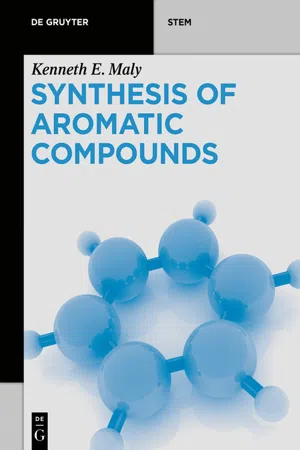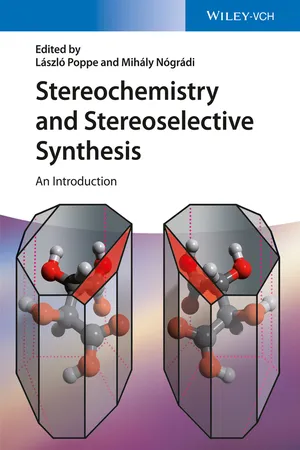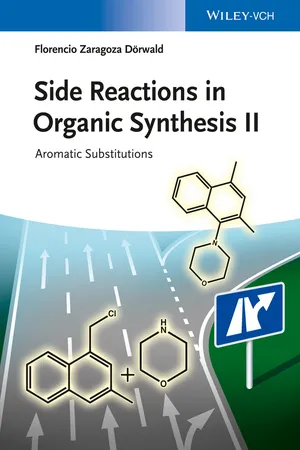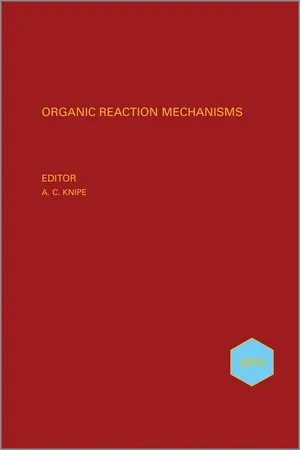Chemistry
Regioselectivity of Electrophilic Aromatic Substitution
Regioselectivity of Electrophilic Aromatic Substitution refers to the preference of electrophilic substitution reactions to occur at specific positions on an aromatic ring. This selectivity is determined by the electronic and steric effects of the substituents already present on the ring, as well as the nature of the electrophile. The regioselectivity can be predicted using various rules and principles.
Written by Perlego with AI-assistance
Related key terms
Related key terms
1 of 4
Related key terms
1 of 3
4 Key excerpts on "Regioselectivity of Electrophilic Aromatic Substitution"
- eBook - ePub
- Kenneth E. Maly(Author)
- 2022(Publication Date)
- De Gruyter(Publisher)
2 Electrophilic aromatic substitution2.1 Introduction
By virtue of their π-bonds, aromatic compounds undergo reactions with electrophiles, often in the presence of a Lewis acid catalyst. However, unlike alkenes, which undergo electrophilic addition reactions, aromatic compounds generally undergo electrophilic substitution, where initial electrophilic addition is followed by a deprotonation to re-aromatize. In this chapter, we will review the basic principles of electrophilic aromatic substitution, the scope of electrophiles that can be introduced onto an aromatic ring, reactivity and regioselectivity considerations, and applications in the synthesis of substituted aromatic compounds.2.2 General mechanistic principles
A generic electrophilic aromatic substitution (also referred to as an SE Ar mechanism) proceeds via an arenium ion mechanism, where the electrophile is attacked by the π-electrons of the aromatic ring to form a cationic intermediate, which is re-aromatized upon deprotonation to give the substituted aromatic ring (Figure 2.1 ).Figure 2.1: Generalized mechanism for electrophilic aromatic substitution.It should be noted that the first step is generally the rate-determining step because aromatic stabilization is broken when the electrophile adds to the ring. The intermediate, referred to as an arenium ion or a Wheland intermediate, does not possess aromatic stabilization but is stabilized by resonance. Deprotonation to form the final product occurs rapidly because aromaticity is restored when the final product is formed. As we will see, the reactivity and regiochemistry of electrophilic aromatic substitution can be explained by this mechanism and in particular by the nature of the arenium ion intermediate. - eBook - ePub
Stereochemistry and Stereoselective Synthesis
An Introduction
- Mihály Nógrádi, László Poppe, József Nagy, Gábor Hornyánszky, Zoltán Boros(Authors)
- 2016(Publication Date)
- Wiley-VCH(Publisher)
There are, however, some processes, when it is problematic to separate the mixture of regioisomeric products. In such instances, regioselectivity may be of help, as, for example, in the enzyme-catalyzed reaction shown in Figure 7.9. Separation of the sulfate esters of 1- and 2-naphthol can be accomplished by regioselective hydrolysis using a sulfatase enzyme. A similar procedure can be carried out with sulfate esters of o- and m-, as well as with o- and p- substituted phenols. Figure 7.9 Regioselective hydrolysis of sulfate esters with sulfatase enzyme. 7.2.2.2 Product Regioselectivity By regioselectivity in a chemical reaction, usually product selectivity taken in a narrower sense is understood. Even within this category, more than one type can be distinguished, and regioselectivity is often mixed up with the concept of chemoselectivity. According to one interpretation, regioselectivity means competition between different regions of the same functional group. For instance, selectivities in the direct 1,2-addition, as well as in Michael - and 1,4-additions, are put by some authors into this category (as quoted in association with chemoselectivity shown in Figure 7.7). According to an alternative interpretation, regioselectivity means selectivity manifested between groups of the same constitution but of different connectedness. The examples in the following two sections demonstrate this case. Regioselectivity in Enol and Enolate Formation A classic example for regioselectivity associated with functional groups is the dependence of enol/enolate formation on reaction conditions (Figure 7.10). Figure 7.10 Regioselectivity in enolate formation. Variations of regioselectivity in enolization can be traced back fundamentally to the difference of kinetically and thermodynamically controlled enolization mechanisms. Protons of the ketones in Figure 7.10 (where R is a simple electron donating alkyl group) are somewhat more acidic at the methyl group - eBook - ePub
Side Reactions in Organic Synthesis II
Aromatic Substitutions
- Florencio Zaragoza Dörwald(Author)
- 2014(Publication Date)
- Wiley-VCH(Publisher)
8 Aromatic Nucleophilic Substitutions8.1 General Aspects
Although less important than aromatic electrophilic substitutions, aromatic nucleophilic substitutions are valuable transformations in organic synthesis. Many drugs, agrochemicals, and other structurally complex compounds comprise aromatic nucleophilic substitutions in their industrial syntheses. Numerous reviews have been published [1–4].8.1.1 Mechanisms
Aromatic nucleophilic substitutions can proceed by an addition–elimination mechanism (SN Ar), by an abstraction–addition mechanism (SN 1), via radicals (SRN 1), or via intermediate formation of an aryne (Scheme 8.1 ). The first mechanism is predominant for electron-deficient arenes or heteroarenes capable of delocalizing a negative charge to electronegative atoms. Electron-withdrawing groups in the ortho or para position to the leaving group enhance the rate of SN Ar reactions, whereas electron-donating groups inhibit them. Particularly powerful rate-enhancing groups are diazonium, iminium, nitroso, and nitro groups.Mechanisms of aromatic nucleophilic substitution.Scheme 8.1Naphthyl derivatives undergo SN Ar reactions particularly readily (Scheme 8.2 ) because the dearomatization of naphthalenes requires less energy than that of monocyclic arenes (only one of the two rings of naphthalene is fully aromatic) [5, 6]. 2-Nitronaphthalenes, for instance, behave chemically more as nitroalkenes than as nitroarenes [7].SN Ar reaction at naphthalenes [6, 8, 9].Scheme 8.28.1.2 Regioselectivity
Because the addition of a nucleophile to an electron-deficient arene is reversible, smooth substitutions will occur only at arenes with good leaving groups. For SN Ar reactions, good leaving groups include fluoride, nitrite, sulfonates, the remaining halides, and sulfinates. In the presence of oxidants, hydride may also be a suitable leaving group. The precise ranking of leaving groups also depends on the solvent (solvation of the nucleophile, the Meisenheimer complex, and the leaving group) and on the nucleophile (hydrogen bonding in the Meisenheimer complex) [10–12]. The amino group, for instance, is a poor leaving group in aprotic solvents, but is easier to displace than chloride by hydroxide in water as solvent (Scheme 8.3 ). 6-(Alkylsulfonyl)purines react faster with MeOH/DBU (1,8-diazabicyclo[5.4.0]undec-5-ene) than 6-iodopurines, but more slowly with aniline than 6-iodopurines [13]. A further example of solvent effects in aromatic nucleophilic substitutions is given in Scheme 8.4 - eBook - ePub
Organic Reaction Mechanisms 2010
An annual survey covering the literature dated January to December 2010
- A. C. Knipe, A. C. Knipe(Authors)
- 2012(Publication Date)
- Wiley(Publisher)
Chapter 6 Electrophilic Aromatic Substitution M. R. CramptonDepartment of Chemistry, University of Durham, Durham, UKGeneral Halogenation Nitration Alkylation, Acylation, and Arylation Reactions Substitutions on Heterocyclic Rings Other Reactions ReferencesGeneral
Interest in electrophilic substitutions continues to expand, with the number of relevant references more than doubling between 2008 and 2010. Much of this interest is concerned with metal-catalysed reactions and in substitutions on heterocyclic compounds.There has been a theoretical study1 of the relative reactivity and site selectivity of substituted phenols, anisoles, pyrroles, and indoles. The method uses four known equations assessing quantities such as local and global softness and hardness, and the nucleophilicity values, N, obtained are in reasonable agreement with experimental values obtained from work from Mayr's group. Density functional theory (DFT) has been used to assess the proton affinity and protonation sites of p-nitroaniline2 and to investigate protonation and methylation pathways for benzene, leading to both kinetically controlled and thermodynamically controlled products.3 An ab initio study of proton transfers between five-membered heterocyclic rings has considered the interplay of resonance, inductive, and polarizability effects together with aromaticity and antiaromaticity. An important conclusion is that, in proton transfers that lead to an aromatic molecule or ion, the development of aromaticity runs ahead of the proton transfer, leading to a lowering of the intrinsic reactivity barrier.4 Platinum and palladium complexes incorporating cationic pyridinium ligands have been shown to be effective catalysts for hydrogen/deuterium exchange in benzene and substituted arenes.5
Index pages curate the most relevant extracts from our library of academic textbooks. They’ve been created using an in-house natural language model (NLM), each adding context and meaning to key research topics.
Explore more topic indexes
Explore more topic indexes
1 of 6
Explore more topic indexes
1 of 4



